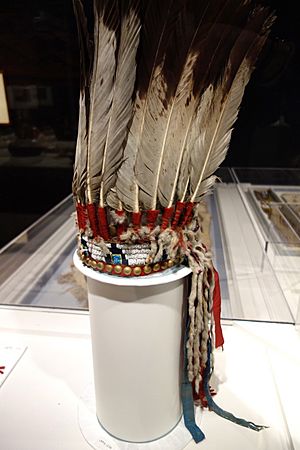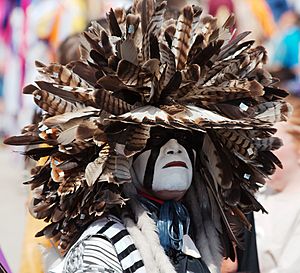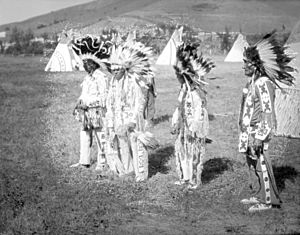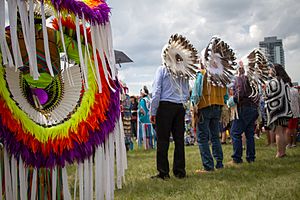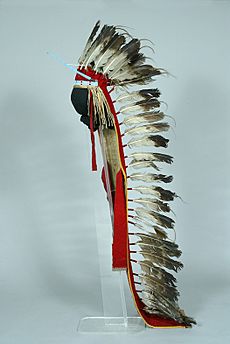War bonnet facts for kids
War bonnets are special feathered headwear. They are traditionally worn by male leaders of the American Plains Indians Nations. These leaders have earned a lot of respect in their tribe. Long ago, they were sometimes worn in battles. Today, they are mostly used for important ceremonies. In Native American and First Nations communities, these items are very important. They hold great spiritual and political meaning. Only those who have earned the right can wear them. This honor comes from formal recognition by their people.
Contents
Why War Bonnets Are Important
Many Native American tribes see an eagle feather as a huge sign of respect. A person must earn their feather through brave and selfless actions. They can also be given feathers for their work or service to their community. Brave deeds include acts of courage in battle. They also include political achievements or helping their community grow.
Eagle feathers are so highly valued. In some cases, like for a warrior of the Cheyenne Dog Soldiers, only two or three feathers might be given in a whole lifetime. In the past, the first warrior to touch an enemy in battle and stay safe received an eagle feather. When enough feathers were collected, they could be made into a headdress. Historically, these headdresses were usually only for the tribe's chosen leaders.
Roman Nose was a very important Cheyenne warrior in the 1860s. He was known for his amazing warbonnet. People believed it protected him during battle. Stories say he rode in front of United States Army soldiers. Even though they shot at him, he was not hurt while wearing his war bonnet.
Historically, women did not wear the common Plains warbonnet style. However, some First Nations women have recently earned high respect. They have been given these headdresses in special ceremonies. This is a new tradition.
Because of their history and importance, wearing war bonnets without permission is disrespectful. Native Americans see it as an insult to their culture. Sometimes, non-Native political leaders have been allowed to wear a headdress. This has caused debate in some cases.
Rules About Eagle Feathers
Plains-style war bonnets are made from eagle feathers. Most tribes of the Interior Plains believe the eagle is the strongest bird. The Eagle feather law allows Native Americans to use eagle feathers. They use them in their traditional spiritual and cultural practices. This rule is part of the Migratory Bird Treaty Act of 1918. In the United States, only members of a federally recognized Native American tribe can legally have eagle feathers.
One old way to get feathers was to carefully take them from young eagles' nests. This could be done three times before the feathers stopped growing back. Up to thirty-six feathers could be collected this way. If the nest was not disturbed, this method could be repeated every year.
Types of Plains-Style Bonnets
Plains Indians use eagle feathers as the most important part of their headdresses. These feathers show honor and respect. Some types of Plains-style bonnets include the "horned" bonnet, the "flaring" eagle feather bonnet, and the "fluttering feather" bonnet.
The "horned" bonnet can have a buckskin skull cap. It might also have shaved bison or cow horns. Dyed horsehair and bunches of owl feathers can be placed under the skull cap.
The "flaring" eagle feather bonnet often uses golden eagle tail feathers. These feathers are attached to a buckskin or felt crown. There are slits at the bottom of the crown. These slits make the bonnet look like it is "flaring" out.
An unusual type is the "fluttering feather" bonnet. Its feathers are loosely attached to a felt or buckskin cap. They hang down at the sides.
Understanding Cultural Appropriation
Native American leaders and activists feel upset when people wear war bonnets without permission. They call this cultural appropriation. This means taking and using parts of a culture without understanding or respecting their meaning. This includes wearing headdresses or other sacred items. It is especially upsetting when non-Natives wear them as fashion or costumes.
This issue is part of a larger effort by Native Americans. They want to highlight what they see as ongoing harm to their cultures. This includes the cultures of indigenous peoples in the United States and Canada. Many musicians and festival-goers have worn warbonnets. This has led to criticism from Native Americans. Some non-Natives have apologized. Several music festivals have even banned selling or wearing them as costumes.
It is important to understand what a headdress means to different tribes. For example, to the Crow and Lakota tribes, it is very sacred. Without this understanding, it is hard for non-Natives to grasp the harm caused. When sacred objects are used for fashion or money by outsiders, it can be very hurtful.
See also
- Toupha
- Plume hunter
- Plumage


